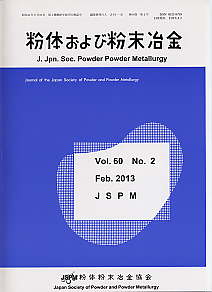All issues

Volume 60, Issue 6
June
Displaying 1-10 of 10 articles from this issue
- |<
- <
- 1
- >
- >|
Paper
Paper
-
Nobuyuki HIRATSUKA, Shozo YUKI, Kenji KAMISHIMA, Koichi KAKIZAKI2013Volume 60Issue 6 Pages 257-262
Published: June 15, 2013
Released on J-STAGE: July 04, 2013
JOURNAL OPEN ACCESSCrystalline nano-sized Ni1−xZnxFe2O4 (x = 0~1.0) particles were prepared by ultrasonic spray pyrolysis from the spray sol-gel solution with Ni –, Zn – and Fe – nitrates and citric acid. The crystal lattice constant increased lineally with increasing Zn ion contents according to the Vegard’s rule. All the prepared particles had the size of less than 100 nm, which were calculated with Scherrer equation and were observed by TEM. The average particle size of the samples containing Zn ions was about 50 nm. The sample with x = 0.3 had the maximum magnetization of 63 emu/g, which was 80 percent of the bulk material. It was supposed that the sample contained a super paramagnetic substance. The coercivity of the samples was much larger than that of the bulk ferrites. The coercivity of the samples decreased with the increase of Zn ion contents. Curie temperature also decreased with the increase of Zn ion contents. However, these values were higher than those of the bulk materials because of existence of Fe2+ ions and heterogeneous octahedral site distribution of Zn ions.View full abstractDownload PDF (973K)
Special Issue:Development of PM Materials Corresponding to Trends in Technology for Automobiles
Summarization
-
Kei Ishii2013Volume 60Issue 6 Pages 264-
Published: June 15, 2013
Released on J-STAGE: July 04, 2013
JOURNAL OPEN ACCESSDownload PDF (150K)
Memorial Lecture of JSPM Award
-
Masayuki YAMAMOTO2013Volume 60Issue 6 Pages 265-270
Published: June 15, 2013
Released on J-STAGE: July 04, 2013
JOURNAL OPEN ACCESSSintered machinery parts have been widely used in automobiles, business machines and home appliances due to their priority of near net shaped parts can be inexpensively produced. On the other hand, with trend toward higher required functions for the parts, conventional sintered parts couldn’t have ensured the functions. Resin composite sintered parts are also one of the measures. So higher function parts that impart feature of sintered parts with feature of resin as hybrid parts that compensate lack of properties of the sintered parts have been developed. In this paper, resin composite piston for shock absorber and torque sensor for electric power steering which characteristically represent the developed parts are described.View full abstractDownload PDF (1093K)
Paper
-
(Influence of Drive System, Teeth Number, Mating Gear Material and Surface Rolling)Teruie TAKEMASU, Masato NAKAMOTO, Takao KOIDE, Yoshinobu TAKEDA, Toshi ...2013Volume 60Issue 6 Pages 271-277
Published: June 15, 2013
Released on J-STAGE: July 04, 2013
JOURNAL OPEN ACCESSSurface durability tests were carried out using powder metallurgy (P/M) pinions and gears made of 1.5Cr-0.2Mo single-press single-sinter (1P1S) high-density (7.55 × 103 kg/m3) sintered steel. A mating gear was made from standard grade Ni – Cr – Mo wrought steel. The P/M gear specimens were machined from sintered packs and some were surface-rolled. All test gears were case-carburized under the identical condition and finished by grinding. A power re-circulating type gear running testing rig was employed. The gear dimensions and the mating gear material were found to scarcely affect the surface durability of as-sintered P/M gears. When the as-sintered P/M gear was set as the driver, the surface fatigue strength after 1.5 × 107 cycles was approximately 10 % smaller than when this gear was set as the follower. The load bearing capacities of the surface-rolled P/M gears were higher than those of the Ni – Cr – Mo wrought steel pinions regardless of the drive system. The finite element analysis of contact stress shows that the maximum shear stress distributions beneath the gear flank surface during loading can explain an appropriate case-hardening depth, a sufficient densification layer by surface rolling and the surface durability properties obtained in gear running tests.View full abstractDownload PDF (1515K) -
(Influence of Initial Density, Case-Hardening Depth and Surface Rolling)Teruie TAKEMASU, Masato NAKAMOTO, Takao KOIDE, Yoshinobu TAKEDA, Toshi ...2013Volume 60Issue 6 Pages 278-283
Published: June 15, 2013
Released on J-STAGE: July 04, 2013
JOURNAL OPEN ACCESSThe rolling contact fatigue tests were carried out using case-carburized rollers made of 1.5Cr – 0.2Mo alloyed sintered steel and SCM415 wrought steel. Two kinds of P/M rollers having the initial density of 7.25 × 103 kg/m3 and 7.60 × 103 kg/m3 were prepared. The effects of the case-hardening depth on the rolling contact fatigue strength were mainly investigated. The failure mode of all P/M rollers was spalling caused by the cracking under the contacting surface. When the effective case-hardening depth was set to 1.2 mm or more, the contact fatigue strength after 2 × 107 cycles of surface rolled P/M rollers reached 2 GPa and the maximum surface damage depth remarkably decreased of about 0.2~0.3 mm, which is almost equivalent to the depth that maximum shear stress becomes the peak. The finite element analysis of contact stress shows that the maximum shear stress distribution descends suddenly at the position that is slightly deeper than the effective case-hardening layer, which is corresponding to the location of the maximum failure depth of spalling when the effective case-hardening depth of P/M rollers was less than 1 mm.View full abstractDownload PDF (1295K)
JSPM Announcements
-
2013Volume 60Issue 6 Pages Pref6_1-
Published: June 15, 2013
Released on J-STAGE: July 04, 2013
JOURNAL OPEN ACCESSDownload PDF (287K) -
2013Volume 60Issue 6 Pages Mtg6_2-Mtg6_5
Published: June 15, 2013
Released on J-STAGE: July 04, 2013
JOURNAL OPEN ACCESSDownload PDF (639K) -
2013Volume 60Issue 6 Pages 243-247
Published: June 15, 2013
Released on J-STAGE: July 04, 2013
JOURNAL OPEN ACCESSDownload PDF (1731K) -
2013Volume 60Issue 6 Pages 248-252
Published: June 15, 2013
Released on J-STAGE: July 04, 2013
JOURNAL OPEN ACCESSDownload PDF (251K) -
2013Volume 60Issue 6 Pages 284-306
Published: June 15, 2013
Released on J-STAGE: July 04, 2013
JOURNAL OPEN ACCESSDownload PDF (727K)
- |<
- <
- 1
- >
- >|